Restaurant employment resumed its upward trajectory
Restaurants expanded payrolls at a moderate pace in March, according to preliminary data from the Bureau of Labor Statistics (BLS).
Eating and drinking places* added a net 28,300 jobs in March on a seasonally-adjusted basis. That followed a downward-revised increase of 28,500 jobs in February.
The February and March gains came on the heels of a 3-month period of below-trend job growth in the industry. Overall between November 2023 and January 2024, eating and drinking place employment declined by nearly 15,000.
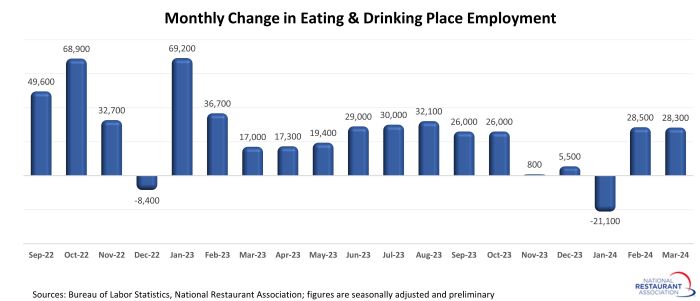
Restaurant employment trends were choppy in recent months, but the industry workforce maintained its position above pre-pandemic levels. As of March 2024, eating and drinking places were 37,000 jobs above their February 2020 employment peak.
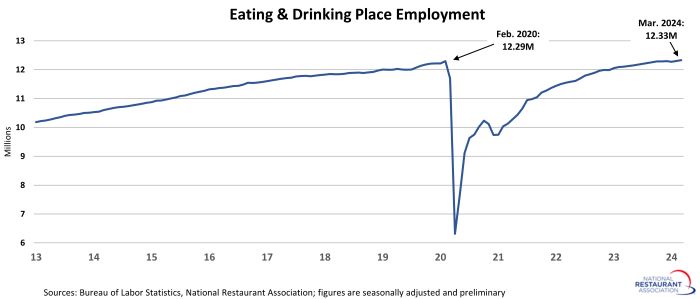
Fullservice segment still down nearly 250k jobs
The fullservice segment experienced the most job losses during the initial months of the pandemic – and it still has the longest path to recovery. As of February 2024, fullservice restaurant employment levels were 248,000 jobs (or 4%) below pre-pandemic readings in February 2020.
Employment counts in the cafeterias/grill buffets/buffets segment (-32%) also remained below their February 2020 levels.
Job losses in the limited-service segments were somewhat less severe during the initial months of the pandemic, as these operations were more likely to retain staff to support their existing off-premises business. As of February 2024, employment at snack and nonalcoholic beverage bars – including coffee, donut and ice cream shops – was 113,000 jobs (or 14%) above February 2020 readings.
Staffing levels in the quickservice and fast casual segments were 140,000 jobs (or 3%) above pre-pandemic levels. Headcounts at bars and taverns were 24,000 jobs (or 6%) above the pre-pandemic peak.
[Note that the segment-level employment figures are lagged by one month, so February is the most current data available.]
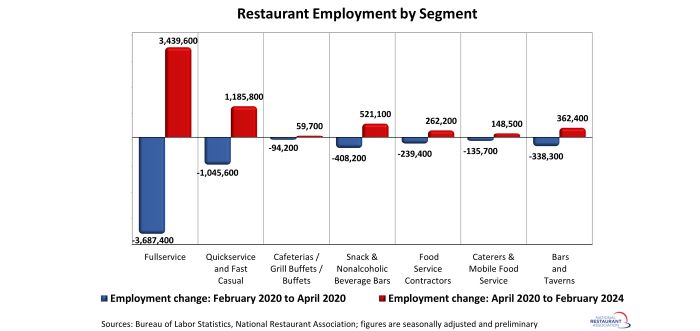
Restaurant workforce recovery uneven across states
Restaurant employment surpassed pre-pandemic readings on the national level, but the extent of the industry’s workforce recovery varies significantly by state. As of February 2024, 26 states and the District of Columbia still had fewer eating and drinking place jobs than they did in February 2020.
This group was led by Maryland, which had 9% fewer eating and drinking place jobs in February 2024 than it did in February 2020. Louisiana (-7%), Vermont (-7%), Massachusetts (-6%), Hawaii (-6%), Maine (-6%) and Illinois (-6%) were also well below their pre-pandemic restaurant employment levels.
As of February 2024, eating and drinking place employment in 24 states surpassed their comparable pre-pandemic readings in February 2020. This group was led by Nevada (+12%), Utah (+12%), Montana (+9%) and Idaho (+8%).
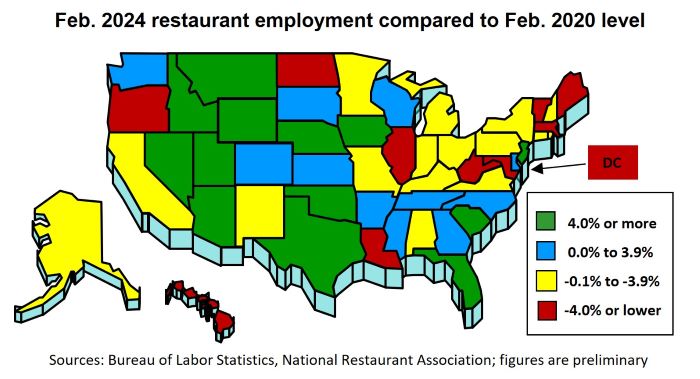
Slower job growth expected in 2024
The restaurant industry will continue expanding payrolls in 2024, albeit at a much slower pace compared to recent years. In total during 2024, the Association expects the overall restaurant and foodservice industry to add an additional 200,000 jobs. That would be only a third of the 600,000 jobs added during 2023.
The expectation of slower job growth is corroborated by the downward trend in job openings. On the last business day of February, there were 927,000 job openings in the combined restaurants and accommodations sector, according to data from the Bureau of Labor Statistics’ Job Openings and Labor Turnover Survey (JOLTS).
That marked the 5th consecutive month with fewer than 1 million job openings, after spending a record 30 months above that level. This indicates a cooling in the demand for employees, though postings still remained above the 2019 average of 875,000 job openings each month.
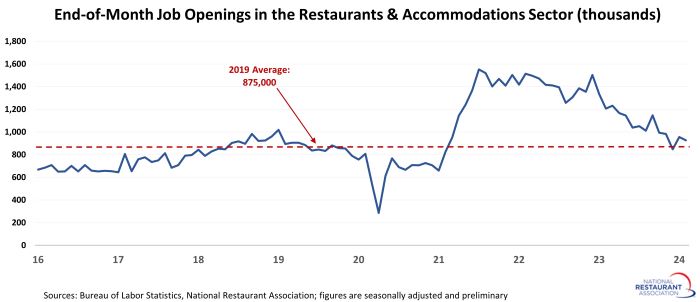
Note: The job openings data presented above are for the broadly-defined Accommodations and Food Services sector (NAICS 72), because the Bureau of Labor Statistics does not report data for restaurants alone. Eating and drinking places account for nearly 90% of jobs in the combined sector.
*Eating and drinking places are the primary component of the total restaurant and foodservice industry, providing jobs for roughly 80% of the total restaurant and foodservice workforce of 15.5 million.
Read more analysis and commentary from the Association's economists, including the latest outlook for consumers and the economy.